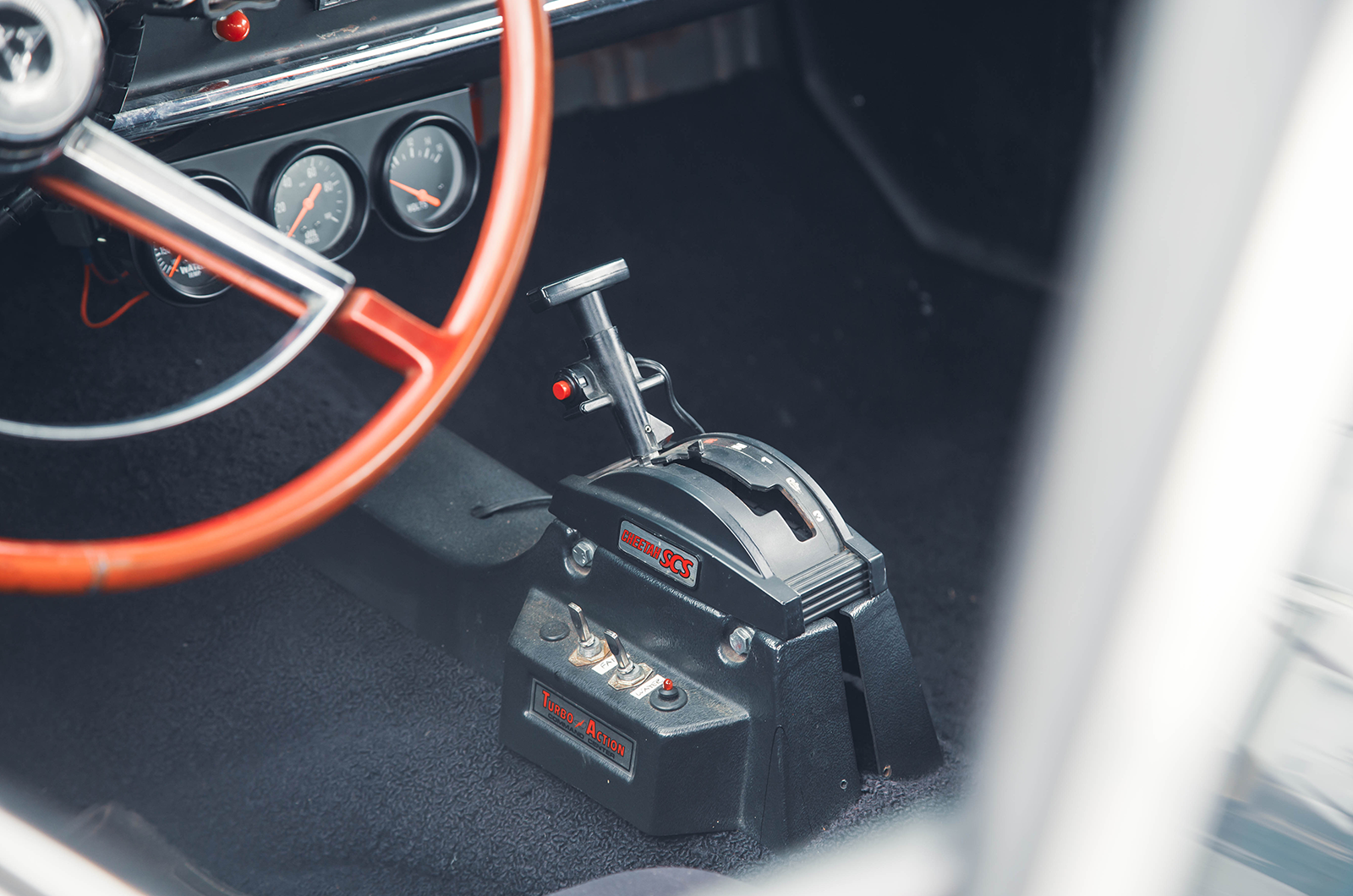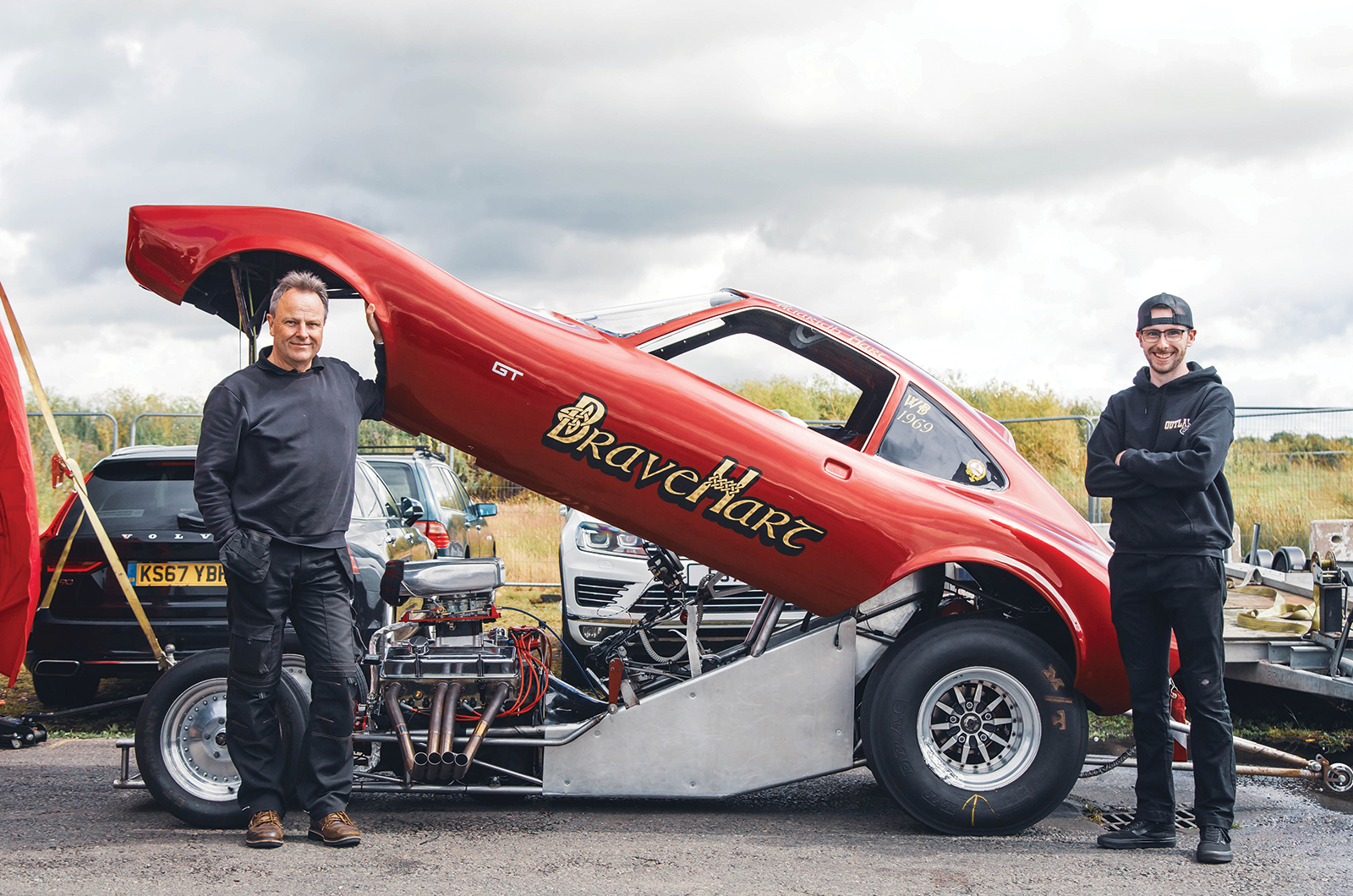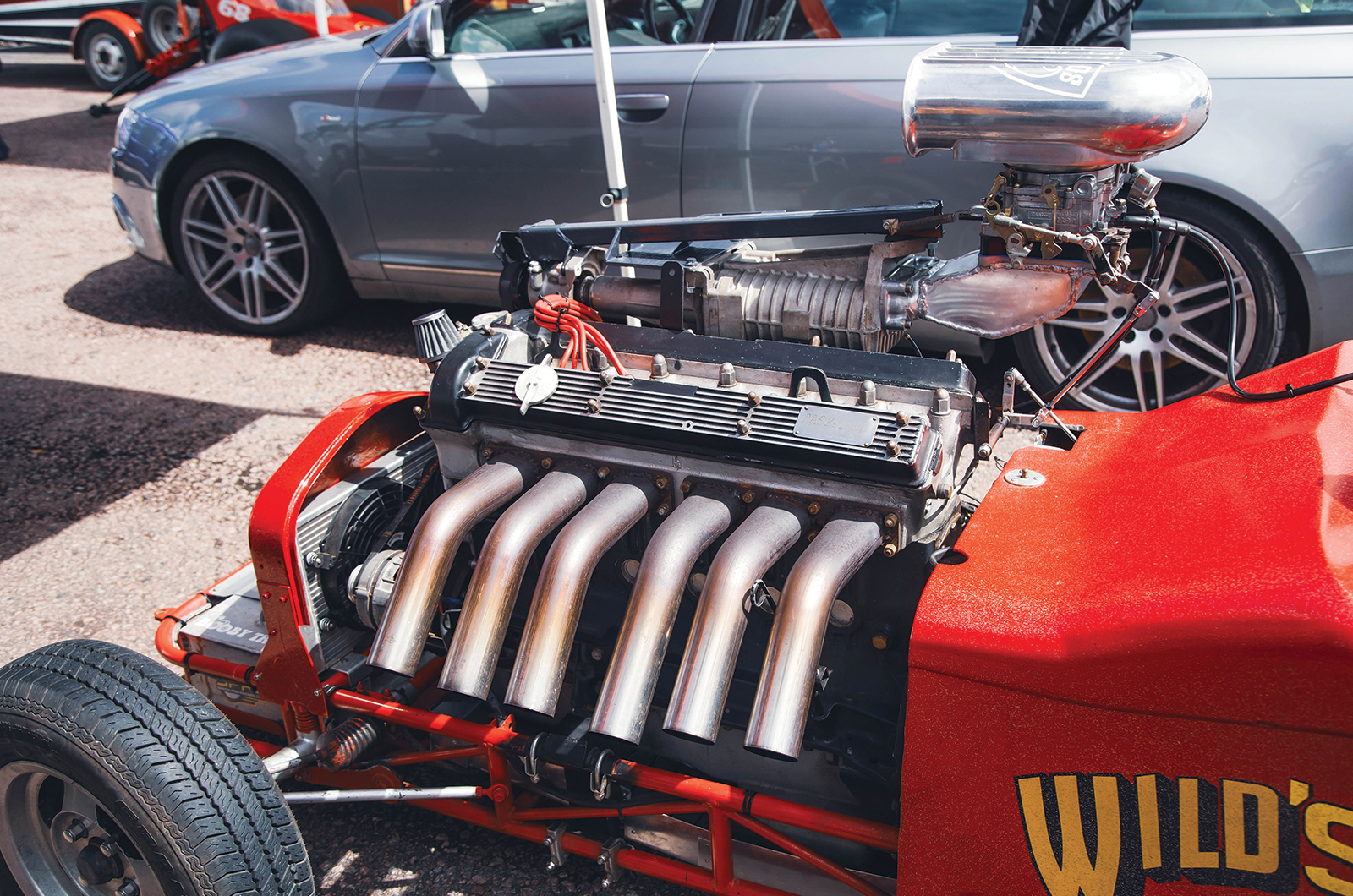When Andy approached Chrysler’s historic division to find out more about his Coronet, he learned that it was sold new by Studio Dodge in Hollywood.
“We wanted to pay homage to the car’s history,” he says of the Dodge’s retro-inspired paintjob.
“Admittedly, when it left the factory it was a bit of a shopping trolley,” he adds.
“It would have had a smaller engine – a 5.2-litre V8 – and was used by someone to get from A to B. Many years down the line, it’s a very different car.”
Ian and Ruaridh Hart: Opel GT Funny Car
Ian (left) and Ruaridh Hart with their Opel GT-inspired Funny Car
Ruaridh and Ian Hart have 50-plus years of drag-racing experience between them.
As a result, their Chevrolet-powered Funny Car, ‘BraveHart’, is no slouch.
“Our personal quarter-mile best is 10.53 secs,” says Ian. “Every time we come we go quicker, which is a pain in a dial-in regularity class.”
Ruaridh has been racing since 2013, and he has had plenty of success in junior categories.
The Opel GT-esque bodywork hides a 300bhp Chevrolet engine
“It’s exhilarating, especially in a car that we’ve built ourselves,” he explains. “You know it’s you who has put the effort in. It’s blood, sweat and tears.”
Starting with a 1980s dragster chassis, their ’69 Opel GT-inspired Funny Car was completed three years ago.
Although few original chassis parts remain, the rear wheels are still attached to the Austin-Healey 3000 axle it came with.
“As standard, this engine would make about 260-270bhp in a Camaro,” Ian says. “Give it a decent manifold and a big carb, let it breathe freely and you’re looking at 300bhp without trying too hard.”
Like many dragsters, this Opel GT Funny Car is a mash-up of parts – the rear axle is from an Austin-Healey 3000
So what’s it like to be strapped into the driver’s seat?
“It’s the weirdest thing,” explains Ruaridh. “During the lead up to and after the run, you’ve got lots of adrenalin, excitement… everything is flowing through you.
“But when I’m actually driving down the track, I’m not really thinking about anything.
“You’re so hyper-focused on the steering, the gearshift points and everything else that it all blurs in your mind.”
Dave Billadeau: Dodge Challenger
Dave Billadeau has 40 years’ experience with American classics
“It’s quick, but it’s what we do,” says Dave Billadeau, who has been modifying and restoring American muscle cars since the 1980s.
“I’ve had a hand in a lot of the cars you see around here,” he adds.
Dave began his working life as a signwriter, before switching to building cars and engines full-time in the early ’90s.
He’s at Dragstalgia with the ’74 Challenger that he has been racing for three seasons.
Chunky tyres and a wheelie bar on this Dodge Challenger drag racer
“It’s an original Superstock car,” he explains. “It was built as a race car from day one. It was used for five years in the USA before being parked up.”
When the car was imported to the UK in 2017 it was in need of restoration, and although there was little in the way of rust, lots of parts needed updating.
Dave was careful not to overdo it, though, and he has kept many original components.
His best time in this car is 9.79 secs at 140mph. “It’s enough to get your attention,” he says.
Ian Wild: Wild Cat dragster
The Wild Cat dragster came together in Ian Wild’s shed
“I’ve always liked Jaguar straight-six engines,” says Ian Wild, who races in the Wild Bunch class with his homebuilt rail dragster, which is powered by a 1986 XJ6 motor.
The Coventry theme continues with the supercharger, which came from an XJR’s 4-litre V8.
The gearbox, originally a Borg-Warner item, is now a GM TH400 transmission from a Daimler limousine.
“It’s also got a Jaguar rear axle,” he continues. “Well, it’s basically a Jag differential with the hubs bolted directly to it.”
Cheeky logo alteration (left); Ian’s home-brewed dragster runs a supercharged Jaguar XJ6 motor
Despite its unlikely origins, this stray Big Cat often posts quick times at Santa Pod.
“I have a stupid grin on my face every time,” laughs Ian.
“The only scary moment was the first time I took it down the strip, because I wasn’t sure if it was going to hold together – it was built in a shed.”
Adam Kruczynski: Chevrolet 210
The off-roader-like ride height of Adam Kruczynski’s Chevrolet 210 aids rearward weight transfer to improve traction
Gasser classes were typically the home of street-inspired, gasoline-fuelled drag cars before Superstock regulations took over.
The comical ride height came about as competitors did their best to shift weight rearwards to maximise traction off the line.
Nearly all Gasser cars use a beam axle up front, such as Adam Kruczynski’s 1955 Chevrolet 210, which was raced in the USA in the 1970s.
Multi-lever gearshift (left); this modified Chevrolet runs in Gasser classes
“I’ve added glassfibre doors and bootlid, but the rest is genuine 1955 Chevy,” he says. “It had a small-block engine and a manual gearbox when I got it.”
Initially, Adam tried to keep the 210 as it was, but he decided to upgrade when the second clutch gave up the ghost.
Now it’s got a big-block Chevy engine, plus a GM TH400 gearbox hooked up to a multi-lever shifter.
The beam axle is clear to see on the jacked-up Chevrolet 210
“I’ve done a 10.99 secs run at 121mph,” he says, “but I haven’t been able to recreate that.”
Adam points to a panel gap on his Chevrolet: “It’s bigger on this side than it is on the other, but it goes down the track straight.
“If it ain’t broke, don’t fix it!”
Grace Roaf and Don Scott: Plymouth SuperBird replica
Don Scott’s Plymouth SuperBird replica makes its presence felt at Santa Pod Raceway
Humidity, track temperature and wind direction are among the variables that crew chief Grace Roaf has to consider when calculating the dial-in time for Don Scott’s Plymouth Road Runner SuperBird replica.
“There are lots of factors,” she explains, “and it’s just guesswork, but you’re guessing to a hundredth of a second, which is mind-boggling.”
Teams set dial-in times based on a prediction of how fast they think they can complete the quarter-mile; the goal is to get as close as possible to this time, without going faster.
This Plymouth SuperBird replica’s livery is inspired by Richard Petty’s NASCAR icon
Grace helps to prepare Don’s car: “It’s set up for straight-line speed,” she says.
“There’s very little maintenance needed between rounds; we check for any leaks and sometimes we’ll pull out the spark plugs to see if it’s running rich or lean.
“The ethos of Superstock is that the cars have to be stock-bodied, pre-1980 American muscle cars.
“They’ve got to have a glass windscreen, plus standard-style front and rear suspension, so we’re running on leaf springs.”
There’s more to drag racing than fast reaction times and flooring the throttle, as Grace Roaf explains
“I’ve been coming with my dad since I was eight,” she continues.
“I just fell in love with the noise and how it makes you feel: when you’re standing next to the cars, you can feel everything shake. And because the pits are so open, you can talk to people easily.
“I got involved with some teams when I was about 12, and I started helping out as pit crew.”
Images: Jack Harrison
Enjoy more of the world’s best classic car content every month when you subscribe to C&SC – get our latest deals here
READ MORE
Normandy Beach Race: classic cars, sun, sea, sand and speed
Classic shrine: Pendine Museum of Land Speed
Heavy metal thunder: Chevrolet Chevelle, Pontiac GTO, Plymouth SuperBird, Dodge Charger and Ford Torino
Ryan Standen
Ryan Standen is Classic & Sports Car’s Editorial Assistant




































